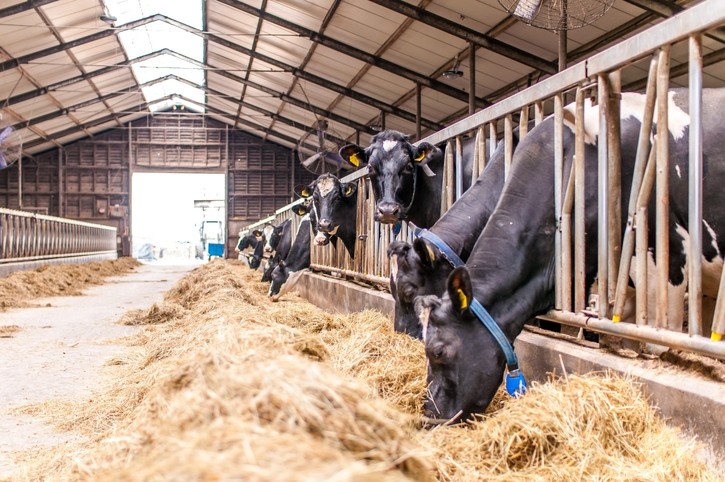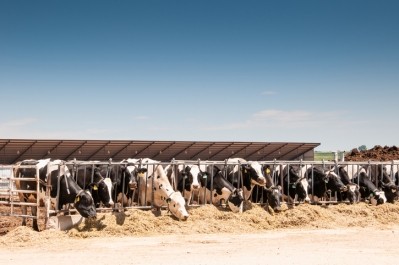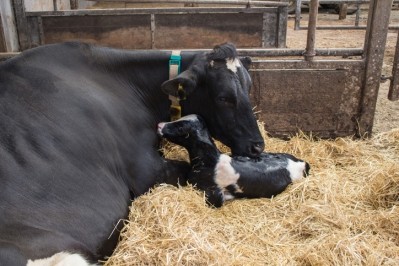Adding lysine to dairy cow diets may improve intake during transition

An international team of researchers from China and the US explored the use of varying dietary energy levels and rumen-protected lysine in feeds for transition dairy cows.
The study was published in the Journal of Dairy Science.
“The objective of the current study was to investigate the effects of close-up supplementation of dietary NEL [net energy levels] (1.53 or 1.37 Mcal/kg of DM) and supplementation of RPL [rumen-protected lysine] (0 or 40 g/cow per day) on FFA [free fatty acids] levels, BHB levels, DMI, and milk production and composition during the transition period in dairy cows,” the researchers said.
The researchers found that providing a high net energy diet lowered levels of free fatty acids and β-hydroxybutyrate (BHB) for prepartum, but not postpartum, cows, while adding rumen-protected lysine (RPL) boosted postpartum dry matter intake (DMI) and reduced concentrations of both serum free fatty acids and BHB.
Energy levels and lysine supplementation did not alter milk yield, milk fat or lactose yield, they said. But, cows receiving the high energy diet and lysine tended to generate more milk than cows on the other feeds and had reduced BHB levels postpartum.
“We concluded that feeding RPL at a rate of 40 g/cow per day, which delivered 9.68 g/d of intestinally absorbable lysine, had beneficial effects on increasing DMI [dry matter intake] and reducing FFA and BHB concentrations in postpartum dairy cows during the transition period."
Energy levels in transition diets
Cows experience physiological and immunological changes when they transition from the gestation period to lactation, the researchers said.
Metabolic disorders tend to be most common during the start of the lactation phase.
During transition, restricted feed intake makes it a challenge to support the cow’s higher nutrient demand and cows may mobilize fat stores and muscle tissue to make up for the deficiencies, they said.
“Most high-producing dairy cows usually face some degree of negative energy balance, which is accompanied by immune suppression around parturition (Goff, 2006) and is associated with a variety of production diseases."
However, the transition period is also important for the lactation cycle and requires “intensive dietary management,” they said.
“Feeding higher energy diets to cows during the dry and close-up periods could improve body condition, but it does not reduce the degree of adipose tissue mobilization during the transition period; it only exacerbates the negative energy balance during early lactation."
Previous research found that overfeeding even moderate amounts of energy could increase metabolic stress and health disorders for postpartum cows in addition to lowering milk yield, they said.
However, cows receiving a high-energy diet before calving showed a better energy balance, higher dry matter intake (DMI), increased concentrations of glucose and insulin in plasma and a drop in non-esterified fatty acids (NEFA) compared to cows on a low-energy feed.
Why add rumen-protected lysine to dairy cow diets?
Increasing energy intake is needed to reduce the risk of cow’s developing a metabolic disorder, however, there are some risks, the researchers said.
“Carnitine is a methylated form of lysine, which acts as a buffer for acetyl residues originating from fat mobilization and thereby reduces ketone body formation and plasma levels of BHB,” they said. “Carnitine is important for oxidation of long-chain fatty acids, regulation of ketosis, support of the immune system, and enhancement of the antioxidant system.”
Feeding supplemental L-carnitine has been linked to a reduction in liver triacylglycerol accumulation for cows, they said. However, because lysine degrades in the rumen, free lysine does not improve the level of lysine available to act as the “carbon backbone for carnitine synthesis.”
Although ways to protect lysine from degradation in the rumen have been developed, little work has been done to explore the interaction of rumen-protected lysine (RPL) and pre-calving energy level during the transition phase, the researchers said. Adding, “The inclusion of lysine is a critical factor in the manipulation of the dietary energy content of TMR fed to close-up cows to control their negative energy balance.”
“We hypothesized that providing transition cows with an increased level of energy and providing RPL would improve DMI, reduce serum free fatty acid (FFA) and BHB concentrations, and increase milk production during the transition period,” they said.
Feeding trial details
During the feeding trial, 68 cows entering their fourth lactation were given one of four diets for from 21 days before expected calving through calving, the researchers said.
All cows revived a low net energy (LE) diet in the dry period before the project started and after calving, all cows had the same lactation ration (1.69 Mcal/kg of dry matter) with or without supplemental lysine through day 21.
The diets trial included one of two energy levels – high (HE) net energy for lactation (NEL) 1.53 Mcal/kg of dry matter or low NEL 1.37 Mcal/kg of dry matter – along with supplemental rumen-protected lysine at 0g/cow per day or 40g/cow per day, they said. Diets were HE with lysine, HE without lysine, LE with lysine or LE without lysine.
Blood samples were gathered on days -21, -14, -7, 0, 3, 7 and 14 related to calving date, they said. Free fatty acid (FFA) and β-hydroxybutyrate (BHB) levels were measured, as was feed offered and refused.
Dry matter intake was calculated, and feed and ort samples were analyzed for components, the researchers said. Cows were also checked for body condition scores weekly from 21 days before expected calving through 21 days post-calving.
Milk samples were gathered for analysis on days 7, 14 and 21 following calving, they said. Milk was checked for fat, protein, lactose, somatic cell counts (SCC) and milk urea nitrogen (MUN).
Results
The pre-calving high energy diet boosted feed intake for postpartum cows and adding lysine to the feeds improved intake for cows both pre- and postpartum, researchers said.
Feeding the higher energy diet before calving lowered FFA and BHB prepartum.
“Our data suggest that the precalving HE diet did not improve the negative energy balance and thereby increase body fat mobilization in postpartum cows,” they added.
The HE diets increased DMI, reduced MUN and tended to increase milk SCC, while cows receiving the lysine supplement tended to generate more milk through week 3 post-calving, they said.
The combination diet lowered BHB and MUN for postpartum cows.
“We hypothesize that RPL increased the bioavailability of carnitine (a methylated form of lysine), which consequently reduced NEFA concentration via β-oxidation, which may impair normal liver function,” the researchers said. “Decreasing NEFA concentration in the liver leads to lower mobilization of adipose tissue and a reduction of serum BHB concentrations.”
Changing diet energy and lysine supplementation did not alter milk components or the yield of milk, milk fat or lactose, they said.
But there was a tendency for increased milk production at week three following calving for cows on the supplemented, high energy diet and cows on that diet saw a drop in MUN.
“Results indicate that feeding a high-energy diet together with rumen-protected lysine improved DM intake and lowered serum free fatty acid and β-hydroxybutyrate concentrations in transition cows,” they said.
Source: Journal of Dairy Science
Title: Effects of close-up dietary energy level and supplementing rumen-protected lysine on energy metabolites and milk production in transition cows
Authors: D. Girma, L. Ma, F. Wang, Q. Jiang, T. Callaway, J. Drackley, D. Bu
DOI: doi.org/10.3168/jds.2018-15962















